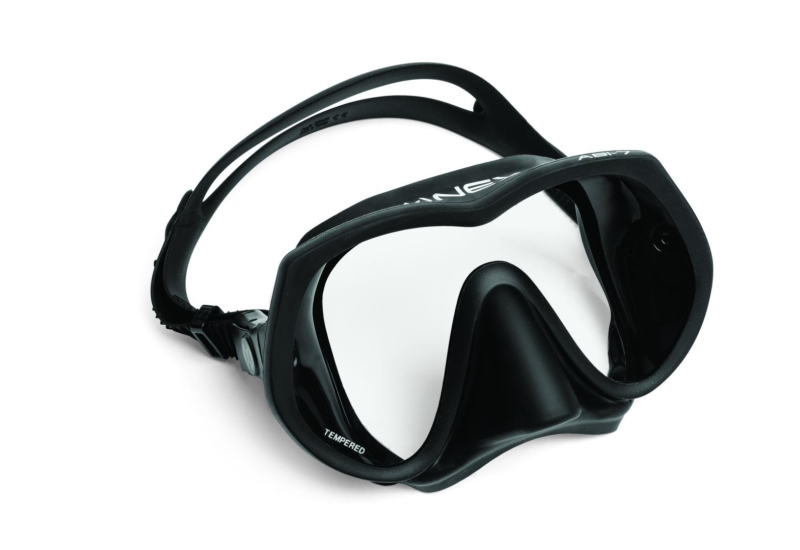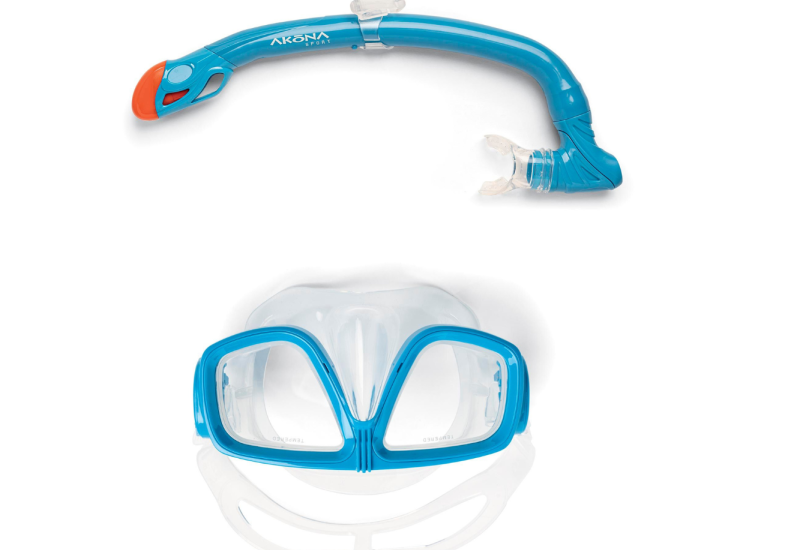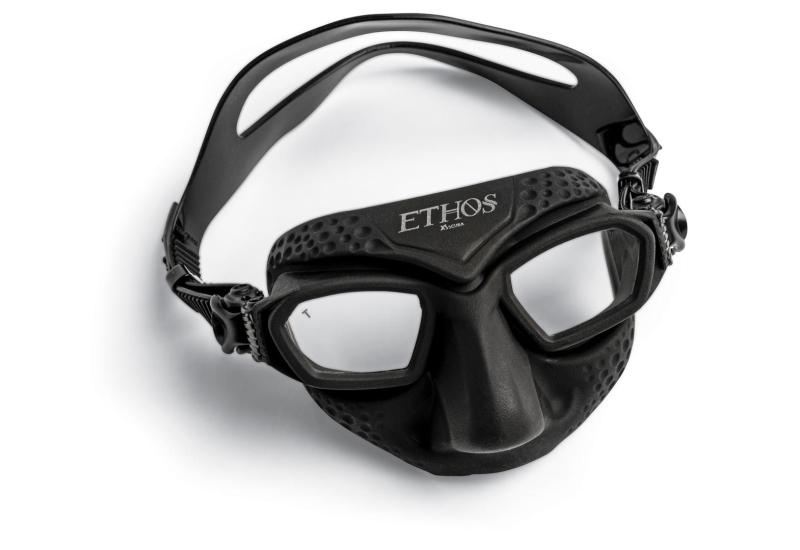10 Frameless Masks
February 2008
Photography by Joseph Byrd
Click here to see ScubaLab's latest mask tests.
Anatomy of a Frameless MaskWhat's the big deal about the new breed of frameless dive masks showing up at your local dive center? It's simple. As a class, frameless masks tend to be lighter, offer a very low profile and they're lower in volume. They fold up flat for easier packing, and as we found in this Scuba Lab review, they also offer a wider field of vision.
How do you make a frameless mask? Throw away the thick plastic frame and attach the buckles directly to the mask skirt. As a result, the lens sits closer to your eyes, offering a broader field of vision in all directions, and with less volume, the mask is easier to clear. They also fold flat for packing and make great backup masks, slipping flat into a BC pocket. For all these reasons, frameless masks have become more popular than ever and companies are responding by offering a growing number of models.
For this review, we asked all major manufacturers to send us their best frameless masks in both black and clear silicone and in small and large sizes (if available) so we could compare them head to head. After charting their features, we took them into the test pool to measure field of view both vertically and horizontally. As a class, the masks reviewed here offer a horizontal field of view between 70 degrees and 85 degrees and a vertical range of view between 65 and 75 degrees. With this data in hand, the Scuba Lab staff then took each mask for a series of dives to see how each one worked in real-world conditions. Here are the individual reviews.
ScubaLab 10 Frameless Masks Chart--(PDF)
Aeris Coral
|||||
|---|---|---|---|
|

|
|

|
|Aeris Coral|
As a no-nonsense, get-it-done frameless mask, the Coral can't be beat. It has a wider-than-average field of vision (80 degrees side-to-side), a firm double-edge skirt seal that molds to your face, an easy-pinch nose pocket and it folds flat for traveling. Getting a comfortable and secure strap placement is easy with swivel buckles and a wide split strap. The Coral comes in Black or Ice (frosted silicone). With the Ice version, the frosted silicone skirt allows just enough light to make out blurry shapes on the periphery out to 180 degrees, enough to detect movement or the presence of a buddy.
Bottom line: The Coral is very comfortable, with a wide range of vision and a reasonable MSRP. Price: $74.95.
Atomic Aquatics Frameless/Medium Fit Frameless
|||||
|---|---|---|---|
|

|
|

|
|Atomic Aquatics Frameless/Medium Fit Frameless|
The shape of the Atomic Frameless lens was computer-designed to maximize field of view both side-to-side and vertically, and no mask tested here could beat it. In both the full-sized version and the slightly narrower Medium Fit version, we measured an impressive 85 degrees of horizontal vision and 75 degrees vertical. In terms of in-water performance, Atomic's choice of top-shelf materials had a number of surprising benefits. The lens is made of UltraClear tempered glass, which reduces distortion and improves light transmission, resulting in better visibility. In the clear skirt version, we were able to see through the skirt with surprising clarity--it was almost as clear as the glass. Bonus: The soft silicone skirt with a wide double-edge seal sticks to your face like a magnet. The nose pocket is roomy, too.
Bottom line: This is our overall favorite frameless mask. It fits great, has a wide field of view, great squeeze-tab buckles, and it folds up flat in a cool low-profile case. Price: $99.
Oceanic Shadow/Mini Shadow
|||||
|---|---|---|---|
|

|
|

|
|Oceanic Shadow/Mini Shadow|
Like the Coral, these masks provide a wide field of view. With the frosted silicone (Ice) version, visual awareness is extended beyond the lens to 180 degrees, but for movement only since the skirt is opaque. It feels sweet on the face and nose and comes with a comfortable strap. The Mini is designed for smaller faces with more rounded sides and a slightly narrower skirt and nose pocket. The shape of the lens allows for the same downward vision but a slightly narrower side-to-side view. Instead of a standard strap, the Shadow comes with a neoprene headband attached to webbing straps that weave through a standard buckle. Adjustment is not as quick, but once set to the right length you don't have to mess with it again.
Bottom Line: The Shadow and Mini Shadow cover all the bases with two distinct sizes in both black and frosted silicone. Both are very face friendly with wide views and reasonable MSRPs. Price: $74.95.
Riffe Frameless
|||||
|---|---|---|---|
|

|
|

|
|Riffe Frameless|
The compact Riffe Frameless is a very low-volume model, even compared to other frameless masks, and it offers a snug nose pocket for easy equalization. Side-to-side visibility is slightly less than others tested, but it also shades the eyes and cuts down on reflections, two features that make the mask a favorite among spearfishers. The silicone skirt's sealing edge is very supple and forms a quick vacuum to your face. The inside of the strap has a textured finish to hold it in place, and there are numbers embossed between each adjustment bar for fine-tuning your fit.
Bottom line: Spearfishermen need every advantage they can get; fish can swim faster and hold their breath longer. The Riffe Frameless may help even the odds. Price: $56.
Scubapro Frameless
|||||
|---|---|---|---|
|

|
|

|
|Scubapro Frameless|
This is the original Frameless mask, first introduced to the market in 1989, and it still performs like a champ. Its rectangular outline has a classic look, and its field of view is right up there with many of the newest lens designs. The double-edge seal is firm but feels good on your face. The silicone skirt feels slightly thicker than others, giving it a durable feel. The square corners of the lens offer nice visibility where others are rounded off. And it still has one of the easiest buckle systems to use on the fly as well as a wide, stable strap.
Bottom line: The Scubapro Frameless has stood the test of time and is still the favorite among many divers. As the saying goes, "if it ain't broke, don't fix it." Price: $129.
Tilos Flex
|||||
|---|---|---|---|
|

|
|

|
|Tilos Flex|
While every other mask in this roundup sports a rigid single-window design, the Flex is a unique two-window mask that bends and twists at the nose bridge. On the surface this seems like a great idea, putting the lens closer to the eyes and widening peripheral vision. When you hit the water, however, you discover this design's limitations. We found it difficult to keep the lenses on the same focal plane, creating distortions that increased the more the two lenses flexed. Side views were unaffected, but looking straight ahead was like wearing someone else's prescription mask. By adjusting the mask for minimal strap tension we were able to eliminate most of the distortion. On the plus side, the Flex was the smallest, lowest volume mask of the group and the most compact for packing, and it comes at a bargain price.
Bottom line: The Flex is the perfect size and price to be a compact backup mask, but be sure to try one in the water to see if the distortion is an issue for you. Price: $33.48.
Tilos Excel
|||||
|---|---|---|---|
|

|
|

|
|Tilos Excel|
The Tilos Excel was the big surprise of this review. It had one of the widest fields of view and a budget-friendly price. With a wide bottom and teardrop shapes below the eyes, the lens favors downward viewing, great for finding belts and buckles on a BC. The top narrows at the temples but has high eyebrows that help when looking up. It all adds up to a combined vertical range of 75 degrees, the same vertical field of view as the two Atomic masks in this review. Bonus: The upper and lower corners of the mask have a tread-like texture that helps wet hands grip the mask when donning and doffing.
Bottom line: You get a lot of vision for your money with the Tilos Excel. Price: $56.95.
XS Scuba Merge
|||||
|---|---|---|---|
|

|
|

|
|XS Scuba Merge|
XS Scuba says this mask merges its best mask features regarding strength and quality. While we might not go that far, it's a pretty nice mask. Its size and shape is similar to the Coral and Shadow. It differs primarily in the buckle system. The buckles attach to a large post that runs through the sides of the mask and takes away about five degrees of side-to-side view, but it still folds down for flat packing. A snug double seal feels good on your face, and the nose pocket is roomy and easy to equalize. The silicone skirt and swivel buckle system seem durable, and the mask comes with a two-year warranty.
- Bring your regulator or a snorkel on your shopping trip, because its mouthpiece will deform your face and affect the mask seal.
- With the reg or snorkel in place, check for fit by placing the mask on your face without the aid of the strap. The skirt should make contact with your skin evenly without gaps.
- Now try the "sniff test" by looking straight ahead and inhaling slightly through your nose--one short sniff should do. This will create just enough of a vacuum to seal the mask to your face. A mask that fits properly should remain stuck to your face without additional inhaling.
- Make sure you can easily reach around the second stage to pinch your nose.
- Pay attention to any pressure points, like contact on the bridge of the nose or a hard skirt pressing against the divot under your nose. If it's even a mild aggravation in the store, it will be agony after an hour underwater.
Bottom line: The Merge makes a perfect backup mask on a budget. It can get the job done with the comfort of more expensive models. Price: $48.
Prep It
In case you missed it in your Open-Water class, there's a reason all new masks fog so readily. A chemical used in the manufacturing process leaves a residue on the lens and traps water. This residue must be removed before diving. It can also leach out of the skirt and strap material causing fogging to persist with frameless masks, which are designed to fold flat, bringing the skirt and strap into contact with the lens between dives.
The solution? Use toothpaste or a mask pre-cleaner (we've had great results with Aquaseal Sea Buff and 500 PSI Mask Scrub) to clean the lens inside and out before you dive with the mask. Use your fingertips to apply the cleaner carefully to all areas of the lens and rinse thoroughly with fresh water. It may also help to wrap the strap of a frameless mask around the front of the lens for storage so it doesn't rest against the inside lens where fog occurs.
It's also important to clean your mask lenses of sunscreen, sweat and salt residue before each dive. Yes, spit will do the job in a pinch, but it also puts bacteria in your mask. We recommend using a high-quality defog solution (Aquaseal Sea Gold, Innovative Scuba Concepts Absolutely Clear and 500 PSI defog all worked well in our last review of defogging solutions) or Johnson's baby shampoo. And to help prevent fogging, keep your mask immersed in fresh water between dives--just don't use the boat's camera rinse bucket or you'll make an enemy out of every shooter on board.
Choosing a Mask
In the market for a new view on the underwater world? Finding a mask that fits your face is the most important step. No cutting-edge design, space-age material or other feature really matters if the mask leaks constantly, bumps up against your nose or rests uncomfortably on your face. Although most manufacturers design their masks to fit a wide segment of the population, there is no one-size-fits-all mask. Try on every mask in the store if you have to in order to find one that fits. Here's how to decide.
Black vs Clear Skirts
Black silicone is a favorite among photographers and hunters because it blocks out unwanted reflections that come through clear silicone skirts. It's similar to wearing a ball cap or visor to shade your eyes. People who prefer clear masks like the feeling of openness, or even extended visibility if the skirt is transparent. At Scuba Lab, we recommend having one of each and using the proper mask for the conditions--black skirts in clear water and clear masks in dark water.
February 2008
Photography by Joseph Byrd
Click here to see ScubaLab's latest mask tests.
Anatomy of a Frameless MaskWhat's the big deal about the new breed of frameless dive masks showing up at your local dive center? It's simple. As a class, frameless masks tend to be lighter, offer a very low profile and they're lower in volume. They fold up flat for easier packing, and as we found in this Scuba Lab review, they also offer a wider field of vision.
How do you make a frameless mask? Throw away the thick plastic frame and attach the buckles directly to the mask skirt. As a result, the lens sits closer to your eyes, offering a broader field of vision in all directions, and with less volume, the mask is easier to clear. They also fold flat for packing and make great backup masks, slipping flat into a BC pocket. For all these reasons, frameless masks have become more popular than ever and companies are responding by offering a growing number of models.
For this review, we asked all major manufacturers to send us their best frameless masks in both black and clear silicone and in small and large sizes (if available) so we could compare them head to head. After charting their features, we took them into the test pool to measure field of view both vertically and horizontally. As a class, the masks reviewed here offer a horizontal field of view between 70 degrees and 85 degrees and a vertical range of view between 65 and 75 degrees. With this data in hand, the Scuba Lab staff then took each mask for a series of dives to see how each one worked in real-world conditions. Here are the individual reviews.
ScubaLab 10 Frameless Masks Chart--(PDF)
Aeris Coral
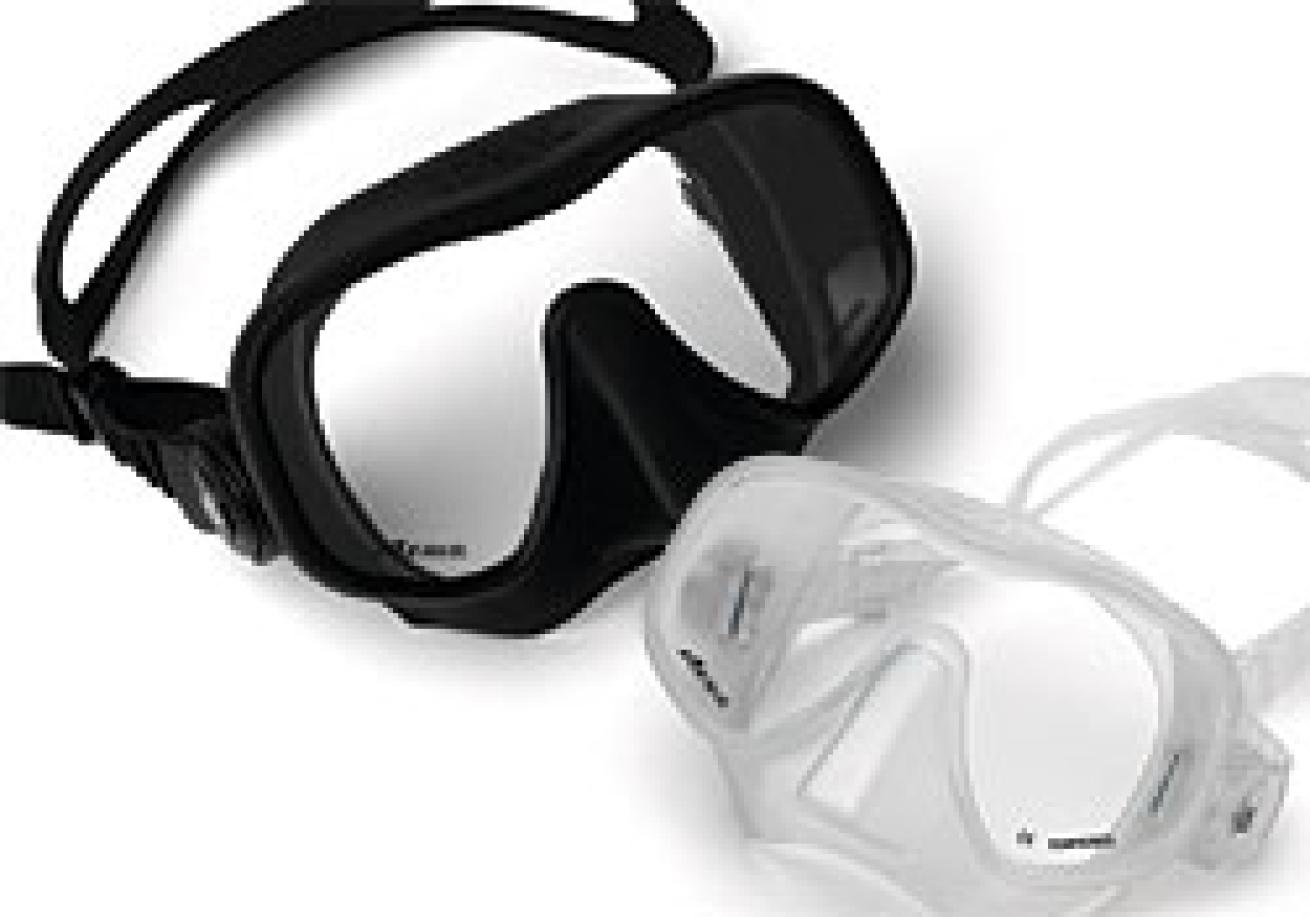
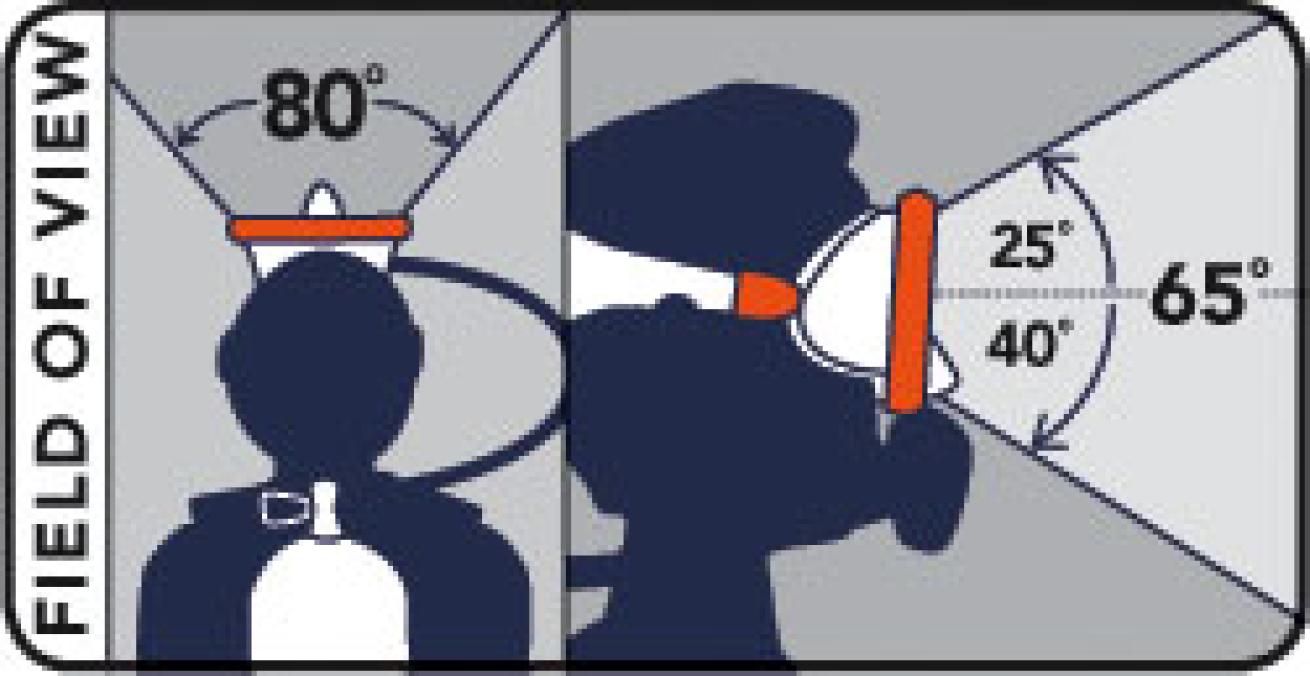
Aeris Coral As a no-nonsense, get-it-done frameless mask, the Coral can't be beat. It has a wider-than-average field of vision (80 degrees side-to-side), a firm double-edge skirt seal that molds to your face, an easy-pinch nose pocket and it folds flat for traveling. Getting a comfortable and secure strap placement is easy with swivel buckles and a wide split strap. The Coral comes in Black or Ice (frosted silicone). With the Ice version, the frosted silicone skirt allows just enough light to make out blurry shapes on the periphery out to 180 degrees, enough to detect movement or the presence of a buddy.
Bottom line: The Coral is very comfortable, with a wide range of vision and a reasonable MSRP. Price: $74.95.
Atomic Aquatics Frameless/Medium Fit Frameless


Atomic Aquatics Frameless/Medium Fit Frameless The shape of the Atomic Frameless lens was computer-designed to maximize field of view both side-to-side and vertically, and no mask tested here could beat it. In both the full-sized version and the slightly narrower Medium Fit version, we measured an impressive 85 degrees of horizontal vision and 75 degrees vertical. In terms of in-water performance, Atomic's choice of top-shelf materials had a number of surprising benefits. The lens is made of UltraClear tempered glass, which reduces distortion and improves light transmission, resulting in better visibility. In the clear skirt version, we were able to see through the skirt with surprising clarity--it was almost as clear as the glass. Bonus: The soft silicone skirt with a wide double-edge seal sticks to your face like a magnet. The nose pocket is roomy, too.
Bottom line: This is our overall favorite frameless mask. It fits great, has a wide field of view, great squeeze-tab buckles, and it folds up flat in a cool low-profile case. Price: $99.
Oceanic Shadow/Mini Shadow


Oceanic Shadow/Mini Shadow Like the Coral, these masks provide a wide field of view. With the frosted silicone (Ice) version, visual awareness is extended beyond the lens to 180 degrees, but for movement only since the skirt is opaque. It feels sweet on the face and nose and comes with a comfortable strap. The Mini is designed for smaller faces with more rounded sides and a slightly narrower skirt and nose pocket. The shape of the lens allows for the same downward vision but a slightly narrower side-to-side view. Instead of a standard strap, the Shadow comes with a neoprene headband attached to webbing straps that weave through a standard buckle. Adjustment is not as quick, but once set to the right length you don't have to mess with it again.
Bottom Line: The Shadow and Mini Shadow cover all the bases with two distinct sizes in both black and frosted silicone. Both are very face friendly with wide views and reasonable MSRPs. Price: $74.95.
Riffe Frameless


Riffe Frameless The compact Riffe Frameless is a very low-volume model, even compared to other frameless masks, and it offers a snug nose pocket for easy equalization. Side-to-side visibility is slightly less than others tested, but it also shades the eyes and cuts down on reflections, two features that make the mask a favorite among spearfishers. The silicone skirt's sealing edge is very supple and forms a quick vacuum to your face. The inside of the strap has a textured finish to hold it in place, and there are numbers embossed between each adjustment bar for fine-tuning your fit.
Bottom line: Spearfishermen need every advantage they can get; fish can swim faster and hold their breath longer. The Riffe Frameless may help even the odds. Price: $56.
Scubapro Frameless


Scubapro Frameless This is the original Frameless mask, first introduced to the market in 1989, and it still performs like a champ. Its rectangular outline has a classic look, and its field of view is right up there with many of the newest lens designs. The double-edge seal is firm but feels good on your face. The silicone skirt feels slightly thicker than others, giving it a durable feel. The square corners of the lens offer nice visibility where others are rounded off. And it still has one of the easiest buckle systems to use on the fly as well as a wide, stable strap.
Bottom line: The Scubapro Frameless has stood the test of time and is still the favorite among many divers. As the saying goes, "if it ain't broke, don't fix it." Price: $129.
Tilos Flex


Tilos Flex While every other mask in this roundup sports a rigid single-window design, the Flex is a unique two-window mask that bends and twists at the nose bridge. On the surface this seems like a great idea, putting the lens closer to the eyes and widening peripheral vision. When you hit the water, however, you discover this design's limitations. We found it difficult to keep the lenses on the same focal plane, creating distortions that increased the more the two lenses flexed. Side views were unaffected, but looking straight ahead was like wearing someone else's prescription mask. By adjusting the mask for minimal strap tension we were able to eliminate most of the distortion. On the plus side, the Flex was the smallest, lowest volume mask of the group and the most compact for packing, and it comes at a bargain price.
Bottom line: The Flex is the perfect size and price to be a compact backup mask, but be sure to try one in the water to see if the distortion is an issue for you. Price: $33.48.
Tilos Excel


Tilos Excel The Tilos Excel was the big surprise of this review. It had one of the widest fields of view and a budget-friendly price. With a wide bottom and teardrop shapes below the eyes, the lens favors downward viewing, great for finding belts and buckles on a BC. The top narrows at the temples but has high eyebrows that help when looking up. It all adds up to a combined vertical range of 75 degrees, the same vertical field of view as the two Atomic masks in this review. Bonus: The upper and lower corners of the mask have a tread-like texture that helps wet hands grip the mask when donning and doffing.
Bottom line: You get a lot of vision for your money with the Tilos Excel. Price: $56.95.
XS Scuba Merge


XS Scuba Merge XS Scuba says this mask merges its best mask features regarding strength and quality. While we might not go that far, it's a pretty nice mask. Its size and shape is similar to the Coral and Shadow. It differs primarily in the buckle system. The buckles attach to a large post that runs through the sides of the mask and takes away about five degrees of side-to-side view, but it still folds down for flat packing. A snug double seal feels good on your face, and the nose pocket is roomy and easy to equalize. The silicone skirt and swivel buckle system seem durable, and the mask comes with a two-year warranty.
Bottom line: The Merge makes a perfect backup mask on a budget. It can get the job done with the comfort of more expensive models. Price: $48.
Prep It
In case you missed it in your Open-Water class, there's a reason all new masks fog so readily. A chemical used in the manufacturing process leaves a residue on the lens and traps water. This residue must be removed before diving. It can also leach out of the skirt and strap material causing fogging to persist with frameless masks, which are designed to fold flat, bringing the skirt and strap into contact with the lens between dives.
The solution? Use toothpaste or a mask pre-cleaner (we've had great results with Aquaseal Sea Buff and 500 PSI Mask Scrub) to clean the lens inside and out before you dive with the mask. Use your fingertips to apply the cleaner carefully to all areas of the lens and rinse thoroughly with fresh water. It may also help to wrap the strap of a frameless mask around the front of the lens for storage so it doesn't rest against the inside lens where fog occurs.
It's also important to clean your mask lenses of sunscreen, sweat and salt residue before each dive. Yes, spit will do the job in a pinch, but it also puts bacteria in your mask. We recommend using a high-quality defog solution (Aquaseal Sea Gold, Innovative Scuba Concepts Absolutely Clear and 500 PSI defog all worked well in our last review of defogging solutions) or Johnson's baby shampoo. And to help prevent fogging, keep your mask immersed in fresh water between dives--just don't use the boat's camera rinse bucket or you'll make an enemy out of every shooter on board.
Choosing a Mask
In the market for a new view on the underwater world? Finding a mask that fits your face is the most important step. No cutting-edge design, space-age material or other feature really matters if the mask leaks constantly, bumps up against your nose or rests uncomfortably on your face. Although most manufacturers design their masks to fit a wide segment of the population, there is no one-size-fits-all mask. Try on every mask in the store if you have to in order to find one that fits. Here's how to decide.
- Bring your regulator or a snorkel on your shopping trip, because its mouthpiece will deform your face and affect the mask seal.
- With the reg or snorkel in place, check for fit by placing the mask on your face without the aid of the strap. The skirt should make contact with your skin evenly without gaps.
- Now try the "sniff test" by looking straight ahead and inhaling slightly through your nose--one short sniff should do. This will create just enough of a vacuum to seal the mask to your face. A mask that fits properly should remain stuck to your face without additional inhaling.
- Make sure you can easily reach around the second stage to pinch your nose.
- Pay attention to any pressure points, like contact on the bridge of the nose or a hard skirt pressing against the divot under your nose. If it's even a mild aggravation in the store, it will be agony after an hour underwater.
Black vs Clear Skirts
Black silicone is a favorite among photographers and hunters because it blocks out unwanted reflections that come through clear silicone skirts. It's similar to wearing a ball cap or visor to shade your eyes. People who prefer clear masks like the feeling of openness, or even extended visibility if the skirt is transparent. At Scuba Lab, we recommend having one of each and using the proper mask for the conditions--black skirts in clear water and clear masks in dark water.

